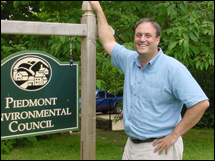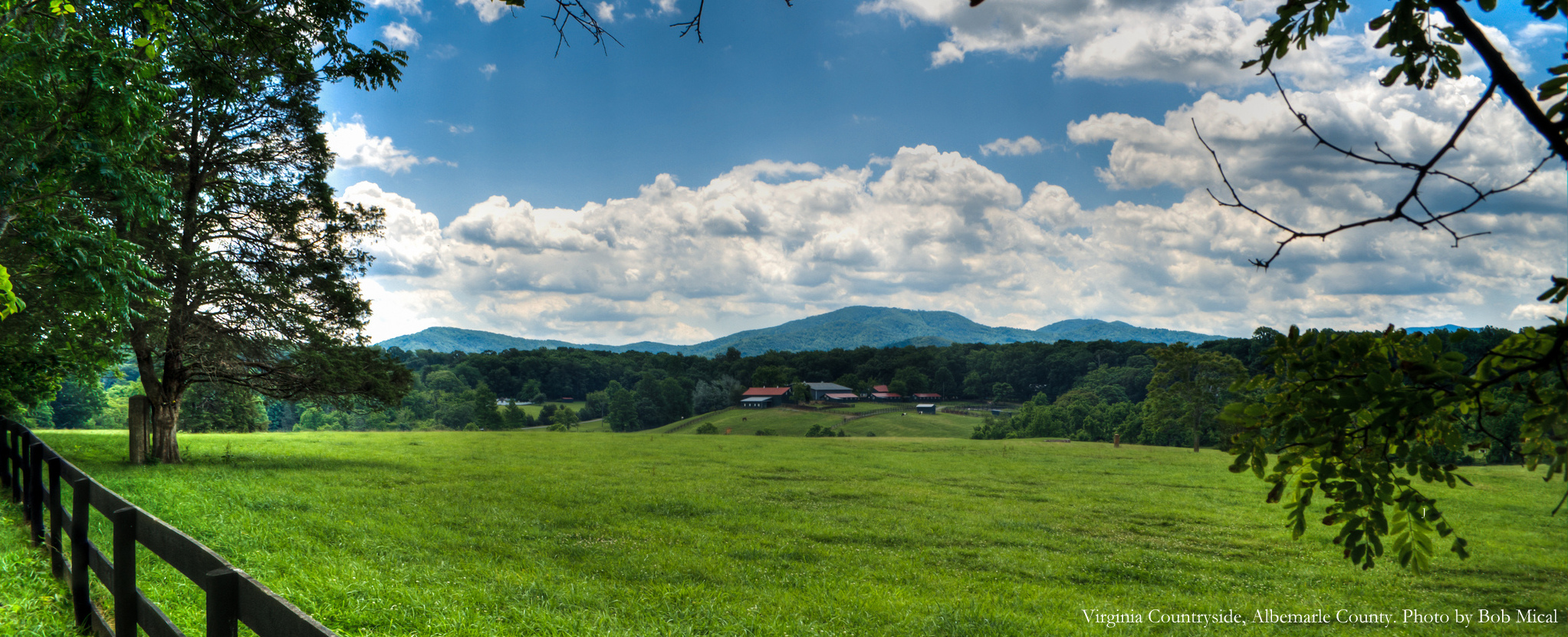This interview series highlights the people who make up the Chesapeake Conservation Partnership. These diverse individuals have devoted their careers to conservation and share a common vision about what that can be achieved through collaboration and partnership. Read more about how these leaders got started, where they are going next, and what drives them forward.
Chris Miller currently serves as the President of Piedmont Environmental Council (PEC), a position he has held since 1996. He is responsible for overall management and strategic planning for PEC, including the land conservation program, energy policy, land use policy, smart growth and transportation policies. Throughout his career, Chris has been a guiding force for conservation in the Piedmont region of Virginia.
How did you come to be involved in conservation?
 As a kid, I spent time with family hunting, fishing hiking, sailing, and working outside. All of those hours outside were some of the best times in my life, both in terms of the experience of the sensations of reality and the human interactions involved in those activities. During college, I had a concentration in Environmental Studies, where I studied regional economics and planning, landscape history, and environmental policy. After time as an intern in the New Zealand Parliament and the Environmental Law Institute, I continued my studies in law and environmental policy at the University of Michigan Law School. After a short time at the law firm of Beveridge and Diamond, I took a job with the Piedmont Environmental Council in November 1993 providing legal advice on regional impacts of the Disney America proposal in Haymarket, Virginia. I have been President of the Piedmont Environmental Council since 1996, during which time there has been an intense focus on expanding land conservation in Virginia. The PEC provided me my first direct experience with private land conservation. When I started, there were 80,000 acres of private land under permanent conservation easement in the PEC service area; as of 2014, nearly 390,000 acres of private land had been voluntarily placed in conservation easement by more than 1200 families. As important, that private land conservation effort enabled PEC to transfer significant lands to the Appalachian National Scenic Trail near Sky Meadow State Park, to the Northern Virginia Regional Park Authority, and to state agencies in the Bull Run Mountain Nature Preserve.
As a kid, I spent time with family hunting, fishing hiking, sailing, and working outside. All of those hours outside were some of the best times in my life, both in terms of the experience of the sensations of reality and the human interactions involved in those activities. During college, I had a concentration in Environmental Studies, where I studied regional economics and planning, landscape history, and environmental policy. After time as an intern in the New Zealand Parliament and the Environmental Law Institute, I continued my studies in law and environmental policy at the University of Michigan Law School. After a short time at the law firm of Beveridge and Diamond, I took a job with the Piedmont Environmental Council in November 1993 providing legal advice on regional impacts of the Disney America proposal in Haymarket, Virginia. I have been President of the Piedmont Environmental Council since 1996, during which time there has been an intense focus on expanding land conservation in Virginia. The PEC provided me my first direct experience with private land conservation. When I started, there were 80,000 acres of private land under permanent conservation easement in the PEC service area; as of 2014, nearly 390,000 acres of private land had been voluntarily placed in conservation easement by more than 1200 families. As important, that private land conservation effort enabled PEC to transfer significant lands to the Appalachian National Scenic Trail near Sky Meadow State Park, to the Northern Virginia Regional Park Authority, and to state agencies in the Bull Run Mountain Nature Preserve.
In your own words, please share why you think land protection is important.
In the United States, much of what determines environmental quality are decisions about land use. Our patterns of development have a huge impact on consumption of energy and the potential pollution of watersheds. Mitigation and adaptation strategies for climate change include conservation of land and the development of strategies for carbon sequestration. Most importantly, land protection, especially on private lands, is a deeply personal way that American individuals and families can be part of important conservation and restoration efforts. People love their land and want to protect it.
When you think about what your organization has accomplished recently, what are you most proud of?
PEC continues to provide the basis for local, regional and statewide organization around land conservation and land protection. Our members are actively engaged in land conservation and best management practices. Our board and staff are leaders in the community, using traditional and innovative ways to get landowners, businesses and government to think about and act on conservation objectives. What I am most proud of is the sustained effort over the past 20 years that has resulted in more than 300,000 acres placed in conservation easement and another 30,000 acres of public lands and a broadly shared vision and land ethic. My biggest frustration and challenge is knowing that the work will always be necessary; over the past 20 years, the region’s population has grown by nearly 200,000 and almost 50% of the land has changed ownership. In Virginia, we have a new Governor every four years and there has been significant change in the legislature. So the work of educating and building a collective vision and support never ends.
What is your vision for your region (or the Chesapeake overall) in the next 5 years?
The next five years will be especially challenging time given the swing status of Virginia and Pennsylvania in national elections and the dramatic shift in politics in Maryland.
My hope is that land conservation will be an area of bipartisan consensus. If we can maintain the current pace of conservation and keep the programs that we already have, we can protect another 50-75,000 acres in the Piedmont region and close to 750,000 in the larger Bay watershed. Those additions will help solidify strategic conservation goals such as the protection of headwaters and upper sub watersheds of the Potomac, Rappahannock and James, an additional block of Civil War battlefields, and another large block of prime agricultural soils. At the same time, thousands of additional landowners will adopt best management practices and improve restoration of habitat.
What is your favorite destination in the Chesapeake Bay watershed? Tell us why it’s at the top of your list.
One of the most interesting experiences in my professional life was to take a helicopter flight from Harper’s Ferry down the Potomac watershed and across the Chesapeake Bay with stops at Tangier Island and Kent Island before returning to Dulles Airport. What makes the Bay watershed so interesting is the range of land types, from ancient bedrock and alpine ecosystems in the Blue Ridge and Bull Run Mountains to the nearly tropical appearance of the coastal marshes near the Choptank, most within a few hours’ drive of the nation’s capital and a population of 18 million with equally as many visitors each year. It may be the most visited watershed in the United States—worth figuring out.

